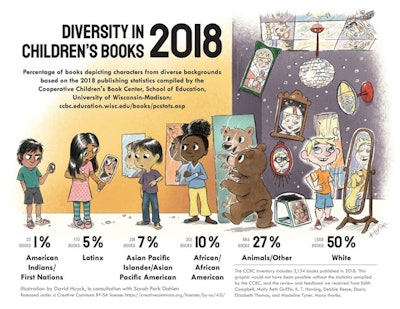As Black educators dedicated to closing racial achievement gaps and preventing low achievement and underachievement, we are quite familiar with the power of literature, especially representation in multicultural literature. The powerful impact can be negative or positive. For example, we have witnessed Black boys (family members, neighbors, students) refusing to read because the book did not have a Black boy on the cover. “I don’t want to read that. I want to read about boys like me” is all too familiar to us. More refreshing, but less commonly, do we hear “I want to read that book with the Black boy” because of the paucity in libraries, bookstores, and school classrooms. When Black boys visit our homes and offices, they are exposed to more multicultural books than in some school and community libraries. We are intentional about representation with this desire to edify the souls, spirits, agency, and identities of children of color. We rail against colorblind (which the first author calls ‘cultureblind’) education. Students bring their rich culture – ways of being – into educational settings; they are done a disservice when their culture is ignored, dismissed, trivialized, misunderstood, and misrepresented. SOURCE; https://readingspark.wordpress.com/2019/06/19/picture-this-diversity-in-childrens-books-2018-infographic/
SOURCE; https://readingspark.wordpress.com/2019/06/19/picture-this-diversity-in-childrens-books-2018-infographic/
In a recent story, we were moved reading about Kenzo. According to the story, “If seeing is believing, count 2-year-old Kenzo as a true believer in the power of representation…During a family viewing of Disney's Encanto, Kah Brand noticed the moment her son realized that one of the characters, a young boy named Antonio, looked very much like him. "He seemed to be in awe, just smiling and staring at the screen," she told POPSUGAR. "Then he stood up and looked back at his dad and me, still smiling. For him, I truly believe that he thought he was seeing himself because of the resemblance between him and Antonio."
Young Kenzo’s experience is not unique, as Wright (2018) explicates in The Brilliance of Black Boys: Cultivating School Success in the Early Grades. The situation is far too common for thousands upon thousands of Black boys early on and throughout their educational preparation.
Rudine Sims Bishop (1990, 1997) is credited with coining the phrase and notion of multicultural literature as mirrors for children of color to see themselves reflected in what they read. Such representation must be what we refer to as ‘R2E2A2L’-- relevant, rigorous, empowering, engaging, accurate, affirming, and liberating. It is troubling that, in 2022, children’s literature remains overwhelmingly white; the books fail to come close to matching, to ‘mirroring’, the diverse school population in which white students are the minority. Larrick’s 1965 article entitled The all-white world of children’s books is evident in the infographic below, in 2018, and could have been written in 2022. Blacks comprise only 10% of books compared to 50 for whites. This underrepresentation contributes to illiteracy and aliteracy. Regis College has compiled a comprehensive list of information -- statistics, predictions, barriers, and resources -- on childhood illiteracy attention to race and ethnicity. Often absent in literacy scholarship and layperson’s knowledge base is aliteracy whereby an individual can read but won’t. They have the ability to read but not the interest. This disengagement is more rationale for R2E2A2L literature overall and, in particular, multicultural literature.
Also important, but neglected, in academic motivation and literature and literacy scholarship (e.g., theories, frameworks, discussions, curriculum and instruction, research), white students must be exposed to high-quality multicultural literature in order to accurately learn more about minoritized individuals and groups. “Children’s literature continues to misrepresent underrepresented communities, and we wanted this infographic to show not just the low quantity of existing literature, but also the inaccuracy and uneven quality of some of those books.”
Multicultural books are a powerful means of decreasing and preventing deficit thinking about Black boys, their peers, classmates, and society. Books for all students must be selected with care, and we recommend the Cooperative Children’s Book Center and Lee and Low Books as resources.
With the thousands of Kenzos in mind, along with Black boys in our personal, communal, and professional circles, we recently wrote Black Boys are Lit: Engaging PreK-3 Gifted and Talented Black Boys Using Multicultural Literature and Ford’s Bloom-Banks Matrix. It features 30 books with Black boys as the protagonist. The books are R2E2A2L. We help teachers leverage Black boys’ identities to guide, inform, and shape how they plan and deliver curriculum and instruction, as well as manage the multicultural, democratic, and culturally responsive classroom. School counselors can utilize these and other books for bibliotherapy. We fill a bibliographic and literacy-oriented void for Black caregivers, like Kenzo’s mother, who can now more readily select and use relevant, rigorous, empowering, engaging, accurate, affirming, and liberating books. It is never too early to provide mirror books. Families and educators should not feel like they are involved in a scavenger hunt when seeking books that fit our R2E2A2L criteria.
Also see:
§ Bishop, R. S. (1990). Mirrors, windows, and sliding glass doors. Perspectives, 6(3), ix-xi.
§ Bishop, R. S. (1997). Selecting literature for a multicultural curriculum. Using multiethnic literature in the K-8 classroom, 1-19.
§ Larrick, N. (1965). The all-white world of children’s books. Saturday Review,48(11),
Dr. Donna Y. Ford is a Distinguished Professor of Education and Human Ecology at The Ohio State University.
Dr. Brian L. Wright is an associate professor and program coordinator of early childhood education at the University of Memphis.
Dr. James L. Moore III, is Vice Provost for Diversity and Inclusion and Chief Diversity Officer at The Ohio State University















